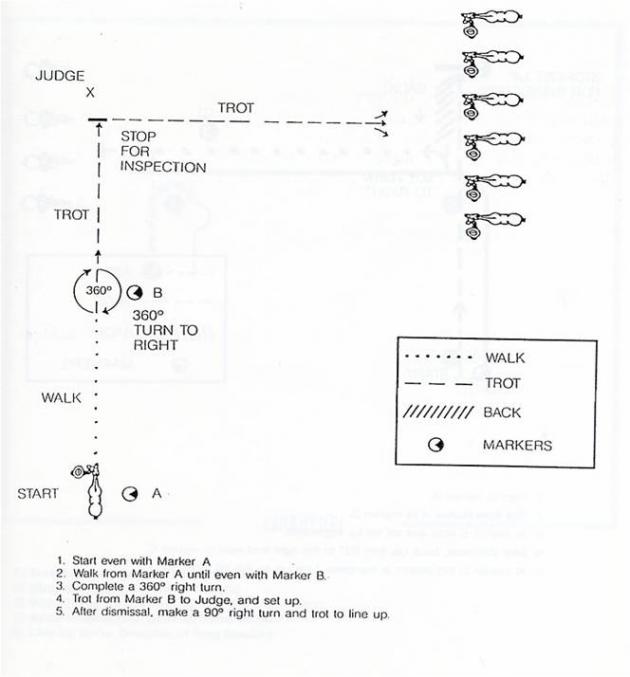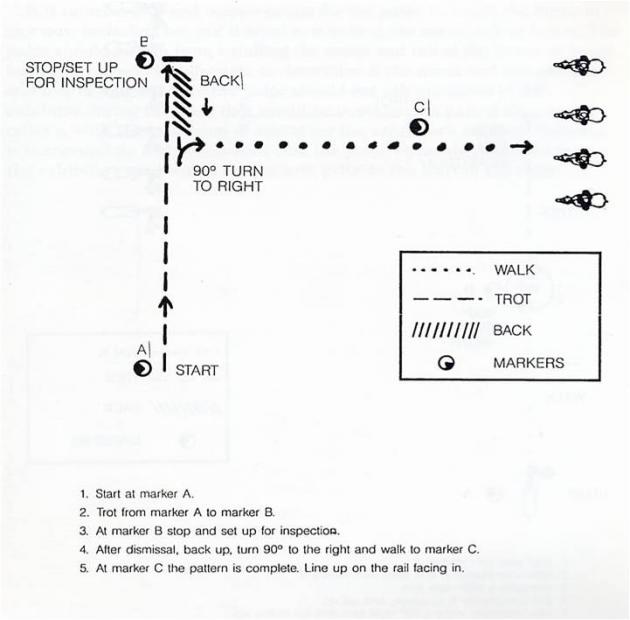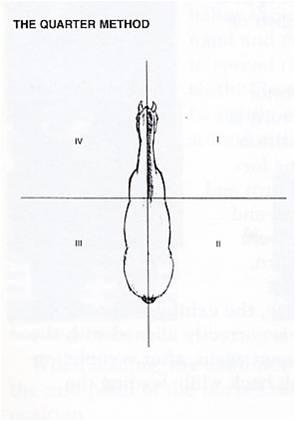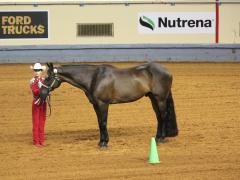The “Showmanship at Halter” event is also known as “Fitting and Showing.” In this class, exhibitors are judged by how they present the horse while performing a specific pattern. As the first class of a day of events, it sets the tone for the day
 .
.
The ideal performance in this class has:
- a poised, confident, and neatly attired exhibitor
- an exhibitor and a horse that quickly and efficiently perform the pattern in the following ways:
- promptly
- smoothly
- precisely
Judge’s Responsibilities
The event consists of specific patterns performed in specific ways. The patterns:
- are posted 1 hour before the class starts
- must be appropriate to fit the size of the show and the skill level of competitors
The judge will:
- set up the cones
- walk the pattern
- answer any questions
- keep it the same for everyone
Sample Patterns


“Quarter Method”
The exhibitor must always be one quadrant away from the judge
Example:

-
- When the judge is in quadrant I, the exhibitor should be in quadrant IV.
- When the judge moves to quadrant II, the exhibitor should move to
- quadrant I.
- When the judge moves to quadrant III, the exhibitor should move to quadrant IV.
- When the judge moves to quadrant IV, the exhibitor should move to quadrant I.
Scoring
There are two different scoring methods in the showmanship event, so the judge must become familiar with each association’s or organization’s rules and regulations. The two different scoring methods are:
- one that is based on a 0 to 100 scale
- one that is based on a 0 to 20 scale
► 0-100 Scoring Method
- 90-100: Excellent showmanship, including body position and presentation of the horse. Completes the pattern accurately, quickly, smoothly, and precisely; demonstrates a high level of professionalism.
- 80-89: Very good performance in execution of the pattern as well as correct showmanship and presentation of the horse. Excellent showman who commits a minor fault.
- 70-79: Good pattern execution and average showmanship. Lacks adequate style and professional presentation to merit elevating to the next scoring range. A very good showman who commits a minor fault, or an excellent showman who commits a major fault.
- 60-69: Fair pattern that lacks quickness or precision. A horse with consistently unwilling attitude or a handler with obvious position and/or presentation faults that prevent effective showmanship. A good showman who commits one minor fault in the performance of the pattern, or an excellent showman who commits a major fault.
- 50-59: One major fault or multiple minor faults in the performance or presentation or position of exhibitor that preclude effective communication with the horse.
- 40-49: Severe fault, two or more major faults, or multiple minor faults in the performance or the execution of the pattern; demonstrates a lack of handling ability and knowledge of correct body position.
- 10-39: Exhibitor commits more than one severe fault or multiple major faults in the performance or position but completes the class and avoids disqualification.
Beginning in 2019, new scoring recommendations will be implemented for showmanship, horsemanship, and equitation.
- The scoring range will be from 0 to infinity with an average score being 70
- Manuever scores will range from +3 to -3
- Scoring range: extremely poor -3, very poor -2, poor -1, average 0, good +1, very good +2, excellent +3
- Recommended for patterns to have 6 to 10 maneuvers to score
- Rider Form and Effectiveness (F&E) will be scored on a range of 0 to +5
- Penalty range: minor penalty -3, major penalty -5, severe penalty -10
Faults
Minor faults (-3)
- Break of gait at walk or jog/trot for up to two strides
- Sliding a pivot foot
- Over or under turning up to 1/8 of a turn
- Lifting a pivot foot during a pivot and replacing it in the same place
- Lifting a pivot foot in a setup and replacing it in the same place after presentation
Major faults (-5)
- Not performing gait or not stopping within 10 feet of designated area
- Break of gait at walk or jog/trot for more than two strides
- Splitting the cone (cone between the horse and handler)
- Horse stepping out of or moving the hind end significantly during a pivot or turn
- Horse stepping out of set-up after presentation
- Horse resting a foot or hipshot in a setup
- Over- or under-turning 1/8 to 1/4
Severe faults (-10)
- Exhibitor is not in the required position during inspection
- Exhibitor touches the horse or kicks or points his or her feet at the horse’s feet during set-up
- Exhibitor stands directly in front of the horse
- Loss of lead shank or holding the chain or two hands on shank
- Severe disobedience, including rearing or pawing or the horse continuously circles the exhibitor
Disqualifications
- Loss of control of the horse that endangers the exhibitor, other horses, or the judge
- Failure of the exhibitor to wear correct number in a visible manner
- Willful abuse
- Horse becomes separated from exhibitor
- Excessive schooling or training, or use of artificial aids
- Knocking over the cone or going off pattern
- Never performing a specific gait
- Excessive schooling or training; use of artificial aids
- Knocking over the cone or going off pattern
- Illegal equipment
- Over or under turning by more than 1/4 turn
► 0-20 Scoring Method

- 10 points toward performance
- 10 points toward appearance of the exhibitor and horse
- Exhibitor should be credited if showing:
- Good, quick set-up
- Turn on correct pivot foot
- Steady hands
- In sync with the horse
- Correct posture
- Consistency in run
- Degree of difficulty/smooth performance
- Correct posture
- Eye appeal
Severe Faults
- Standing in front of the horse
- Changing hands on lead
- Touching the horse with hand or foot
- Omitting parts of the pattern
- Working on the wrong side of the cone
- Turning the wrong direction
- Knocking over a cone
- Obvious disobedience of the horse
- Using illegal equipment such as spurs, chaps, leg wraps, protective boots, etc.
Disqualifications
- Willful abuse
- Excessive schooling or training
- Failure of exhibitor to wear correct number in a visible manner
- Use of artificial aids
- Loss of control of the horse that endangers the exhibitor, other horses or exhibitors, or the judge
Resources
• World Championship Showmanship Video
- Updated sample pattern score sheet



